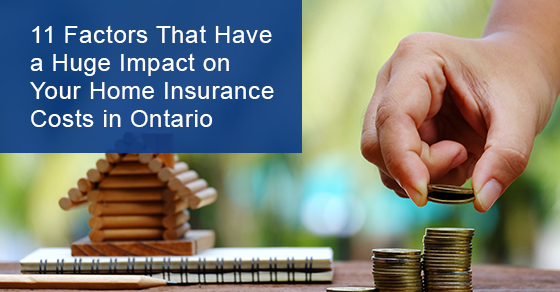
11 Factors That Have a Huge Impact on Your Home Insurance Costs in Ontario
Posted by
on
Apr 27, 2022 in
Having the right home insurance coverage is key to protecting one of the most significant investments in your lifetime. The average home insurance cost in Ontario varies greatly depending on where you live, the value of your home, your insurance history, and many other factors. For example, if you own a home in Ottawa, you can expect to pay anywhere between $700 and $2000 per year for insurance. Insurance companies calculate your premium based on many elements, each determining your probability of making an actual claim. Here are some key factors that can impact your home insurance cost.
1. Location
On average, homeowners in Ontario pay the most for home insurance for Canada. However, the actual cost varies depending on the city and neighbourhood where your home is located. Insurance providers track the claim rate of each postal code area and use this data to determine the likelihood of you making a claim. The types of claims made in the past are also important. For example, you’re likely to incur a higher premium or get limited coverage if you live in a flood or earthquake-prone area. Your insurance company will also look at the crime rate of your neighbourhood. Areas with high historical instances of vandalism and theft will raise your rates.2. Proximity to fire hydrants and fire stations
You might not have considered this factor when buying a new home, but the distance from the nearest fire hydrant and fire station can affect your home insurance cost. Proximity to fire services means your home will be served more quickly and have fewer damages or losses in a fire. This should not be a big issue if you live in a major city like Ottawa, but it could be a factor if you live in a rural area.3. Replacement cost of the home
The rebuild value, or the replacement cost, of your home, is how much it would cost to rebuild the same house if it were destroyed. This is different from the resale market value as it does not include the value of the land. The greater the rebuild value, the higher your premium will be. Some factors that determine your home’s rebuild value include:- The age of your home
- The size of your home
- Construction materials
- Square footage
4. Age and construction of the home
The age of your home affects your home insurance premium in many ways. In general, the older the house, the greater the likelihood of structural problems and damages. Outdated plumbing, electrical, and heating systems will likely hike your insurance premium. For example:- A knob-and-tube electrical system
- Lead or galvanized piping
- Oil or wood-burning stoves
5. Age of the roof
The roof is the primary protector of your home from the outside elements. Roof damage is a typical home insurance claim, especially in Canada, where heavy snowfalls and extreme cold can be particularly harsh on the roof. You’ll likely receive a discount if you have a newer roof or use weather-resistant roofing materials.6. The basement
A finished basement will likely raise your home insurance rates as it means more equipment and furnishings to include in your policy. If you have a home theatre, a gym or any other features in your basement, you must ensure these items have the coverage you need in the event of a claim.7. Swimming pools and hot tubs
Are you thinking about installing a pool or a hot tub? You may want to consider how it will affect your home insurance premium. These items often involve slipping, tripping, and other injuries. It’s advised that you have home insurance coverage to help protect you and limit your liability in these situations.8. Other structures on the property
Your home insurance will increase if you have other structures on your property, including:- Garages
- Decks
- Sheds
- Outbuildings
9. Mitigation devices in the house
Installing damage prevention and mitigation devices in your home may lower your home insurance premium. Examples of these devices include;- Fire and smoke alarms
- Carbon monoxide alarms
- Security alarms or systems
- Burglar alarms
- Security cameras
- Sewer backup valves
- Water sensors

